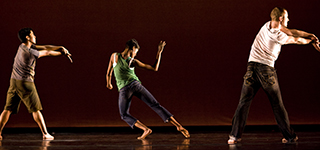Dance event: Everyone gets a chance to perform
September 21, 2008
At one venue, open mic-styled nights focus on a medium other than just music-
dancing.
At the free event Dance Chance, held at the Ruth Page Center for the Arts, 1016 N. Dearborn St., three emerging Chicago choreographers are given a chance to present their work in front of a live audience. The diverse audience and artists then dive into a conversation sharing feedback about the piece. At the end of the night, three new performers are chosen through a lottery-style drawing to perform the next month.
With all types of artists, ranging from visual artists to website creators, moderating the monthly event, it creates a sense of community for young artists, Debbie Kristofek, an event organizer, said.
“The whole thinking behind it is to build a community around dance and bring in a new audience for dance,” Kristofek said.
Along with giving new choreographers a chance to claim the stage every month, Kristofek said the event also has tried to gain an eclectic presentation of moderators. Visual artist Vin Reed moderated the artist discussion on Sept. 15 with choreographer Sherry Zunker in August.
Kristofek also said she thought Dance Chance could become a great place for college students to go on dates.
“It’s better than a movie,” She said. “It’s live dance performance. You never know what you’re going to get.”
The idea for the event came about when DanceWorks Chicago and the Ruth Page Center collaborated to create an event for artists. Though they have different goals, Dance Chance, which first debuted in March, is a way for both organizations to achieve their goals.
A new program of DanceWorks Chicago debuts Sept. 30. Dance Flight has two 45-minute segments within one evening, which may be viewed separately or together. Similar to how Dance Chance is based on an open mic night, Dance Flight is based on a wine flight, which is a wine tasting event.
“Dance Works is all about the development of artists, their growth and setting them up to be future leaders,” Kristofek said. “The Ruth Page Center is all about being a center and a home for dance in Chicago.”
The dances range from abstract dance to hip-hop, with very few boundaries to constrict the choreographers.
“[Dance Chance gives] young artists an opportunity to hone their craft, develop their skills, to interact with the audience and to develop an individual presence in the arts,” Kristofek said.
Dance Chance is not only focused on the artists trying to break into the mainstream, but drawing in a new audience as well.
“[Dance Chance is] a point of entry [for people] to begin to understand dance to be able to discuss,” Kristofek said. “[The audience can] share their opinions and not feel like dance is something that is so far removed.”
Dionna Pridgeon, a dance teacher, was the second to present her dance to the audience in a Sept. 15 session.
“Sometimes when you create work you only have your own opinion and your dancers,” Pridgeon said.
The event allows any choreographer or dancer to enter in the drawing. The only requirement is their attendance.
“I think it’s brilliant,” Pridgeon said. “It gets choreographers exposed in the city that probably would not get exposed. It brings people who don’t know who you are to see your work.”
About 80 people attended Dance Chance on Sept. 15, many of whom are artists.
First timer Karli Walker, a dancer with the Thodos Dance Chicago, beamed with excitement after the show.
“It’s a cool concept,” she said. “It helps the viewers and the choreographers. Most shows, you leave and you wonder where that came from, but you get to hear it [from the artist].”
While there are other shows that give the artist audience feedback, Kristofek said, Dance Chance gives an opportunity for a valuable exchange with new artists who may not otherwise have that opportunity.
“In terms of being a young emerging choreographer the greatest challenge is to find a stage, a place to show your work and to get feedback from an audience,” she said.
Pridgeon said she found out she would be performing only five days before the Sept. 15 performance. She recruited four dancers and practiced for hours every day prior to the show. After the performance, the moderator, Reed, brought her out in front of a cheering audience.
“Everything has to come from the heart,” Pridgeon said. “I can think of a movement all day, but if it doesn’t mean anything to me, I won’t put it on stage.”








